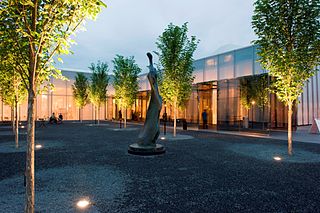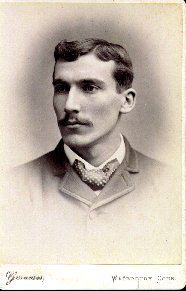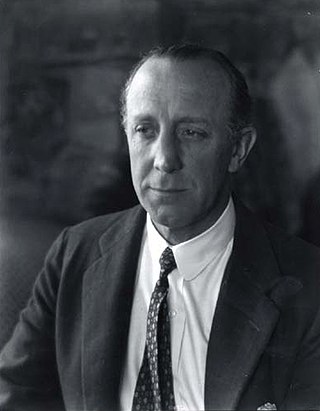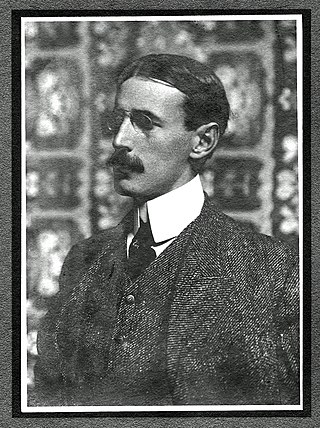Related Research Articles

Edgar Degas was a French Impressionist artist famous for his pastel drawings and oil paintings.

André Derain was a French artist, painter, sculptor and co-founder of Fauvism with Henri Matisse.

George Wesley Bellows was an American realist painter, known for his bold depictions of urban life in New York City. He became, according to the Columbus Museum of Art, "the most acclaimed American artist of his generation".

William Merritt Chase was an American painter, known as an exponent of Impressionism and as a teacher. He is also responsible for establishing the Chase School, which later would become Parsons School of Design.

Frank Weston Benson, frequently referred to as Frank W. Benson, was an American artist from Salem, Massachusetts known for his Realistic portraits, American Impressionist paintings, watercolors and etchings. He began his career painting portraits of distinguished families and murals for the Library of Congress. Some of his best known paintings depict his daughters outdoors at Benson's summer home, Wooster Farm, on the island of North Haven, Maine. He also produced numerous oil, wash and watercolor paintings and etchings of wildfowl and landscapes.

The North Carolina Museum of Art (NCMA) is an art museum in Raleigh, North Carolina. It opened in 1956 as the first major museum collection in the country to be formed by state legislation and funding. Since the initial 1947 appropriation that established its collection, the Museum has continued to be a model of enlightened public policy with free admission to the permanent collection. Today, it encompasses a collection that spans more than 5,000 years of artistic work from antiquity to the present, an amphitheater for outdoor performances, and a variety of celebrated exhibitions and public programs. The Museum features over 40 galleries as well as more than a dozen major works of art in the nation's largest museum park with 164-acres. One of the leading art museums in the American South, the NCMA recently completed a major expansion winning international acclaim for innovative approaches to energy-efficient design.

Stephen Arnold Douglas Volk was an American portrait and figure painter, muralist, and educator. He taught at the Cooper Union, the Art Students League of New York, and was one of the founders of the Minneapolis School of Fine Arts. He and his wife Marion established a summer artist colony in western Maine.

Henry Golden Dearth was a distinguished American painter who studied in Paris and continued to spend his summers in France painting in the Normandy region. He would return to New York in winter, and became known for his moody paintings of the Long Island area. Around 1912, Dearth changed his artistic style, and began to include portrait and still life pieces as well as his paintings of rock pools created mainly in Brittany. A winner of several career medals and the Webb prize in 1893, Dearth died suddenly in 1918 aged 53 and was survived by a wife and daughter.

William Henry Goodyear (1846–1923) was a noted architectural historian, art historian, and museum curator. He was the son of Charles Goodyear (1800–1860), inventor of rubber vulcanization, and Clarissa Beecher Goodyear.

Paul Hampden Dougherty was an American marine painter. Dougherty was recognized for his American Impressionism paintings of the coasts of Maine and Cornwall in the years after the turn of the 20th century. His work has been described as bold and masculine, and he was best known for his many paintings of breakers crashing against rocky coasts and mountain landscapes. Dougherty also painted still lifes, created prints and sculpted.

Emil Fuchs was an Austrian–American sculptor, medallist, painter, and author who worked in Vienna, London and New York. He painted portraits of Queen Victoria and Edward VII and was fashionable among London high society in the early 20th century.
Hickory Museum of Art (HMA) is an art museum in Hickory, North Carolina which holds exhibitions, events, and public educational programs based on a permanent collection of 19th to 21st century American art. The museum also features a long-term exhibition of Southern contemporary folk art, showcasing the work of self-taught artists from around the region. North Carolina's second-oldest museum, Hickory Museum of Art was established in 1944.
Paul Austin Wayne Whitener (1911-1959) was an American landscape painter and museum director. He founded the Hickory Museum of Art in 1944, and served as Director until his death in 1959.

Frederick Ballard Williams was an American landscape and figure painter. He is best known for his decorative and idyllic scenes of the New England landscape. As a member of the National Academy, Salmagundi Club president, and founder of the American Artists Professional League, Williams was an influential figure in the promotion of 20th-century art in America.

Brooklyn Bridge is a 1915 painting by the French artist, theorist and writer Albert Gleizes. Brooklyn Bridge was exhibited at the Montross Gallery, New York, 1916 along with works by Jean Crotti, Marcel Duchamp and Jean Metzinger.

Gabrielle de Veaux Clements was an American painter, print maker, and muralist. She studied art at the Philadelphia School of Design for Women, Pennsylvania Academy of the Fine Arts, and in Paris at Académie Julian. Clements also studied science at Cornell University and graduated with a Bachelor of Science degree. She created murals, painted portraits, and made etchings. Clements taught in Philadelphia and in Baltimore at Bryn Mawr School. Her works have been exhibited in the United States and at the Paris Salon. Clements works are in several public collections. Her life companion was fellow artist Ellen Day Hale.

Henry Seymour Chase Jr., better known by his professional name Harry Chase, was an American artist who specialized in marine paintings.

Elizabeth Bradford is an American artist living in Davidson, North Carolina, best known for her large-scale paintings of landscapes. Her works have been widely exhibited throughout the southeastern United States and are collected in museums and collections, both private and corporate, across the country.
Susan Kaprov is an American multi-disciplinary artist whose work spans the fields of photography, painting, graphic design, and installation art.
References
- ↑ Portraits by Wilford S. Conrow. N.d. Artist File. Hickory Museum of Art, Hickory, NC.
- 1 2 Wilford Seymour Conrow: Morning, N.d. Jan. 2014. "Faces and Figures" Exhibition Label Copy. Hickory Museum of Art, Hickory, NC.
- ↑ "Conrow, Wilford Seymour." AskArt. N.p., 2000-2014. Web. 16 July 2014.
- 1 2 3 4 "Wilford Seymour Conrow." Hickory Museum of Art- American Collection: Fiftieth Anniversary Edition. Hickory, NC: Hickory Museum of Art, 1994. 76-77. Print.
- ↑ Perryman, Thomas, and Mildred Whitener Coe. Catawba Native Paul Whitener: A Retrospective: Exhibition Catalogue. Hickory, NC: Hickory Museum of Art, 1998. Print.